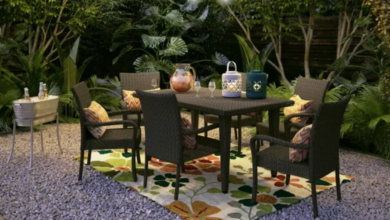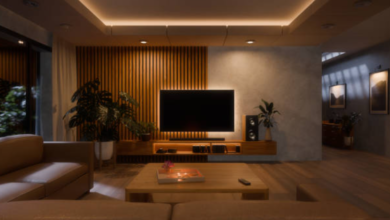How to Choose the Right Flooring for Every Room in Your Home

Introduction: Why Flooring Selection Matters in Home Design
When it comes to home design, one of the most impactful decisions you’ll make is choosing the right flooring. The floors set the foundation—literally and stylistically—for every room. From the cozy comfort of your bedroom carpet to the practical elegance of kitchen tiles, flooring plays a vital role in defining both the look and function of your living spaces. Whether you’re renovating or building a new home, understanding how to choose the right flooring for every room in your home ensures long-term satisfaction, style, and comfort.
Key Factors to Consider Before Choosing Flooring
Budget and Cost Efficiency
Before diving into design preferences, determine how much you’re willing to invest in flooring. Some materials like hardwood or marble are more expensive, while laminate and vinyl offer budget-friendly alternatives without compromising too much on aesthetics.
Durability and Maintenance Needs
Different rooms endure varying levels of foot traffic and wear. High-traffic areas like hallways or kitchens require durable flooring like tile or vinyl, whereas bedrooms might benefit from softer surfaces like carpet.
See also: 10 Budget-Friendly Home Improvement Projects You Can Do This Weekend
Aesthetic Appeal and Style
Choose a flooring option that complements the overall style of your home—be it rustic, modern, or minimalist. The color, texture, and finish all contribute to your interior’s personality.
Climate and Moisture Levels
In regions with high humidity or in areas like bathrooms and basements, moisture-resistant flooring like porcelain tiles or waterproof vinyl is essential to prevent warping or mold growth.
Comfort and Usage Frequency
Rooms where you stand for long periods, like the kitchen, may benefit from more forgiving surfaces like cork. Bedrooms and playrooms should offer comfort and insulation.
Flooring Options for the Living Room
Hardwood Flooring: Warmth & Sophistication
Hardwood is a timeless option for living rooms. It adds natural beauty, increases home value, and comes in various wood species and stains. It’s ideal for homes seeking elegance and long-lasting appeal.
Laminate and Engineered Wood: Cost-Effective Alternatives
Laminate mimics the look of real wood but at a lower cost. Engineered wood has a real wood veneer over plywood, offering better resistance to temperature and humidity changes.
Carpets for a Cozy Ambience
Wall-to-wall carpet adds warmth, reduces noise, and is especially comfortable underfoot. It’s perfect for creating a relaxed and cozy living space, particularly in colder climates.
Best Flooring for the Kitchen
Tile Flooring: Water Resistance and Easy Cleaning
Ceramic or porcelain tiles are popular in kitchens due to their water resistance and easy maintenance. They’re durable and available in a wide range of styles and colors.
Luxury Vinyl: Stylish and Practical
Vinyl planks or tiles are waterproof, cushioned, and come in styles that replicate wood or stone. They’re ideal for kitchens where spills and foot traffic are common.
Cork: Comfortable and Eco-Friendly
Cork offers natural cushioning, is eco-conscious, and resists mold and mildew. It’s also quiet, making it a smart choice for open-concept kitchen layouts.
Choosing Flooring for the Bedroom
Carpet: Quiet, Soft, and Insulating
Carpet remains the top choice for bedrooms thanks to its plush feel, noise reduction, and insulating properties. It helps retain warmth, making bedrooms cozier.
Hardwood and Engineered Wood for Classic Appeal
For those who prefer elegance over softness, hardwood offers a clean, sophisticated look. Add area rugs for warmth without sacrificing aesthetics.
Area Rugs to Personalize the Space
Even with hardwood or laminate floors, a well-placed area rug can provide color, texture, and comfort, while defining space in larger rooms.
Optimal Flooring for Bathrooms
Porcelain and Ceramic Tiles
These tiles are waterproof, easy to clean, and resistant to stains and humidity. Textured finishes can help prevent slips.
Waterproof Vinyl Options
Luxury vinyl tiles (LVT) are gaining popularity for bathrooms. They’re budget-friendly, waterproof, and easier to install than tile.
Avoiding Hardwood and Carpet
Due to high moisture levels, avoid carpet and solid hardwood in bathrooms, as they can absorb water and lead to mold or damage.
Functional Flooring for the Home Office
Quiet, Comfortable Surfaces for Productivity
Consider carpets or cork flooring to reduce noise and provide comfort for long hours. These surfaces create a warm, productive ambiance.
Easy-to-Clean and Stylish Flooring Ideas
Vinyl and laminate are sleek, low-maintenance, and affordable—great for converting a spare room into a professional space.
Ideal Flooring for Basements and Laundry Rooms
Moisture-Resistant Options
Basements require materials that won’t be damaged by moisture. Vinyl, tile, and sealed concrete are safe, durable choices.
Concrete, Vinyl, and Tile Choices
Concrete is long-lasting and cost-effective. Luxury vinyl and tile offer more visual appeal while maintaining practicality in damp areas.
Pet and Kid-Friendly Flooring Options
Scratch-Resistant and Easy-Clean Surfaces
Laminate, vinyl, and tile stand up well to heavy play and pet activity. They’re easy to clean and don’t absorb stains easily.
Non-Toxic and Safe Materials
Opt for low-VOC flooring to ensure indoor air quality. Cork, bamboo, and certain vinyl brands offer safety and comfort for pets and children.
Eco-Friendly Flooring Choices
Bamboo, Cork, and Recycled Wood
Bamboo grows rapidly, making it sustainable. Cork is harvested without cutting down trees. Reclaimed wood adds character and reduces waste.
Low VOC and Sustainable Manufacturing
Look for certifications like GreenGuard or FloorScore to ensure your flooring is low in volatile organic compounds (VOCs) and eco-consciously produced.
Maintenance Tips for Different Flooring Types
Cleaning and Preservation Techniques
Sweep hardwood regularly and mop with appropriate cleaners. Use rugs in high-traffic areas to minimize wear.
Protective Coatings and Treatments
Apply sealants to tiles or grout, and refinish wood floors every few years to extend their lifespan.
Matching Flooring to Interior Design Themes
Rustic, Modern, Minimalist, and Traditional Styles
Choose distressed wood for rustic themes, polished concrete for modern aesthetics, or simple laminate for minimalist design.
Color Schemes and Texture Choices
Cool tones complement contemporary homes, while warm hues add charm to traditional interiors. Texture adds depth and character.
Flooring Mistakes to Avoid
Ignoring Room-Specific Needs
One-size-fits-all rarely works in flooring. Each room has unique requirements—don’t ignore them when selecting materials.
Poor Installation Planning
Improper subfloor preparation or skipping professional help can result in costly repairs. Always ensure correct installation.
Cost Comparison Table of Popular Flooring Types
| Flooring Type | Avg. Cost per Sq. Ft. | Lifespan | Maintenance Level |
|---|---|---|---|
| Hardwood | $6–$12 | 25–100 years | Moderate |
| Laminate | $2–$5 | 10–30 years | Low |
| Carpet | $3–$7 | 5–15 years | High |
| Vinyl (LVT) | $2–$7 | 10–20 years | Low |
| Tile (Porcelain/Ceramic) | $3–$10 | 20–50 years | Low |
| Cork | $5–$8 | 10–25 years | Moderate |
| Bamboo | $5–$7 | 20–25 years | Moderate |
Frequently Asked Questions (FAQs)
Q1: What is the most durable flooring option for high-traffic areas?
A: Porcelain tile and luxury vinyl are among the most durable, ideal for kitchens, hallways, and entryways.
Q2: Which flooring is best for homes with pets?
A: Scratch-resistant and waterproof options like vinyl, tile, or laminate work best for pet owners.
Q3: Can hardwood be used in kitchens?
A: Yes, but it requires regular sealing and careful maintenance to prevent water damage.
Q4: Is cork flooring good for allergies?
A: Yes, cork is hypoallergenic, resists mold, and doesn’t trap dust, making it allergy-friendly.
Q5: How often should carpet be replaced?
A: Typically every 5–15 years depending on traffic, quality, and maintenance.
Q6: What’s the most eco-friendly flooring option?
A: Bamboo and cork are top eco-friendly choices due to their renewability and sustainable harvesting methods.
Conclusion: Final Tips and Best Practices
Choosing the right flooring for every room in your home doesn’t have to be overwhelming. By considering factors like durability, style, budget, and room-specific needs, you can make smart, stylish, and functional decisions that enhance your home’s comfort and value. From warm hardwood in the living room to waterproof tiles in the bathroom, there’s a perfect floor for every space.




